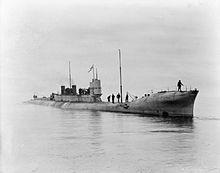Battle of the Isle of May
As a battle of the Isle of May ( Engl. : Battle of May Iceland ) is a serious boat accident, the British Royal Navy in the Firth of Forth called. On the night between 31 January and 1 February 1918 in the Scottish collided funding more submarines of the K-class among themselves and with surface vessels, with more than a hundred sailors were killed, sank two submarines and several lower and surface vessels of war damage were.
procedure
On the evening of January 31, 1918, a task force of about 40 ships left the Scottish naval base Rosyth . The warships were supposed to join forces with other groups from Scapa Flow the next day . The aim of the top-secret mission was a large-scale Home Fleet training mission known as Operation EC1 .
The fleet leaving Rosyth consisted, among other things, of the 5th Battle Squadron with three battleships and escorting destroyers , the 2nd Battlecruiser Squadron with four battlecruisers and escort ships, two other cruisers and each of a light cruiser guided 12th and 13th submarine flotillas.
The boats K3 , K4 , K6 and K7 belonged to the 12th submarine flotilla led by the HMS Fearless . The submarines K11 , K12 , K14 , K17 and K22 together with their lead ship HMS Ithuriel formed the 13th submarine flotilla.
At around 6:30 p.m., the first units of the association weighed anchor and left the naval base. After the last units left, the fleet formed a chain of ships almost 50 km long. For fear of German submarine attacks, the ships drove darkened with dimmed position lights and in absolute radio silence .
Parts of the fleet, which was running at very high speed, encountered a small formation of British minesweepers near the Isle of May and evaded. During the evasive maneuver, the steering system of the K14 jammed , which is why the submarine swerved out of the line. The K22 followed the weak position lights of her lead ship K14 and also left the formation unintentionally. When the K14 tried to resume the course of the fleet, the two submarines collided, killing two sailors. The battle cruiser HMS Inflexible , which followed in the formation, rammed the bow of the unpowered K22 27 minutes later . The two submarines brought up the rear of the 13th submarine flotilla. The three remaining submarines of the flotilla noticed the accident and turned back to help the wrecked boats.
The returning 13th submarine flotilla was on a direct collision course with the following 12th submarine flotilla, which was not informed by the radio silence ordered. The HMS Fearless rammed the K17 . The submarine was badly damaged and sank in 8 minutes. In the general confusion that followed, the K6 ran across the K4 and tore it in two. The remains of the K4 were rammed by the K7 shortly afterwards , sank in a few moments and pulled the entire crew of the submarine into the depths.
Because of the radio silence mentioned, the following ships did not suspect the debacle either. The entire 5th battle squadron drove through the sea area at full steam and killed several of the survivors of the K17 who were helplessly drifting on the surface . Only 9 seafarers could be rescued alive, one of whom died shortly after the rescue.
The British Navy lost 105 men and two submarines in 75 minutes. Four other submarines and a light cruiser were badly damaged.
Conclusion
The May Island debacle was the worst in a long chain of K-Class accidents. The submarines were designed to operate in close association with fast surface units. Since diesel engines could not reach the speeds of modern surface warships at the time, the boats had a steam turbine drive as a special design feature. The boats were very fast over water, but difficult to maneuver due to their size. The many collision accidents showed that the concept of deploying submarines in close battle lines was a total failure.
The " Battle of May Island " counts in addition to the losses of the Surcouf (1942, 130 dead), USS Thresher (1963, 129 dead), K-141 Kursk (2000, 118 dead), USS Scorpion (1968, 99 dead), HMS Thetis (1939, 99 deaths) and K-129 (1968, 98 deaths) on the worst accidents in submarine history .
literature
- Robert Hutchinson: KAMPF UNDER WASSER - Submarines from 1776 to today , Motorbuchverlag, Stuttgart, 1st edition 2006, ISBN 3-613-02585-X
- Anthony Preston: The history of the submarines , Karl Müller Verlag, Erlangen, German edition 1998, ISBN 3-86070-697-7
Coordinates: 56 ° 11 ′ 9 ″ N , 2 ° 33 ′ 27 ″ W.
